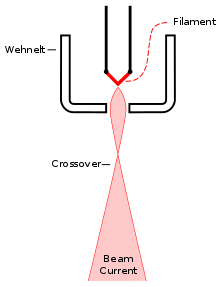Wehnelt cylinder

A Wehnelt cylinder (also known as Wehnelt cap, grid cap or simply Wehnelt) is an electrode in the electron gun assembly of some thermionic devices, used for focusing and control of the electron beam. It is named after Arthur Rudolph Berthold Wehnelt, a German physicist, who invented it during the years 1902 and 1903.[1] Wehnelt cylinders are found in the electron guns of cathode ray tubes and electron microscopes, and in other applications where a thin, well-focused electron beam is required.
Structure
A Wehnelt cap has the shape of a topless, hollow cylinder. The bottom side of the cylinder has an aperture (through hole) located at its center, with a diameter that typically ranges from 200 to 1200 µm. The bottom face of the cylinder is often made from platinum or tantalum foil.
Operation
A Wehnelt acts as a control grid and it also serves as a convergent electrostatic lens. An electron emitter is positioned directly above the Wehnelt aperture, and an anode is located below the Wehnelt. The anode is biased to a high positive voltage (typically +1 to +30 kV) relative to the emitter so as to accelerate electrons from the emitter towards the anode, thus creating an electron beam that passes through the Wehnelt aperture.
The Wehnelt is biased to a negative voltage (typically −200V to −300V) relative to the emitter, which is usually a tungsten filament or Lanthanum hexaboride (LaB6) hot cathode. The Wehnelt bias voltage creates a repulsive electrostatic field that suppresses emission of electrons from most area of the "V" shaped cathode. If the tip of the "V" is close to the aperture of the Wehnelt, then by finely adjusting the bias, some area at the tip of the "V" will have a net electric field (due to both attracting anode and repulsive Wehnelt) that is actually pulling electrons out from the tip (instead of pressing them back). Electrons can only emit from this area, the size of which can be controlled by the bias. Thus, changing the bias not only changes the focusing property of the electrostatic field, it also controls the effective size of the electron source, which is crucial for formation of an electron beam that is to be focussed into a very small spot(for scanning electron microscopy) or a very parallel beam (for diffraction experiment). Although a smaller source can be imaged to a smaller spot, or a more parallel beam, one obvious trade off is a smaller total beam current. Operationally, one can always increase the negative bias until the emitting area is totally "pinched", with total emission current equal to 0. The real operation bias is a little more positive than this pinch bias, and determined by a balance between beam quality and beam current.
References
- ↑ Fleming, Ambrose (1934). "On the history and development of the thermionic valve". Journal of Scientific Instruments. 11 (2): 44. Bibcode:1934JScI...11...44F. doi:10.1088/0950-7671/11/2/303.